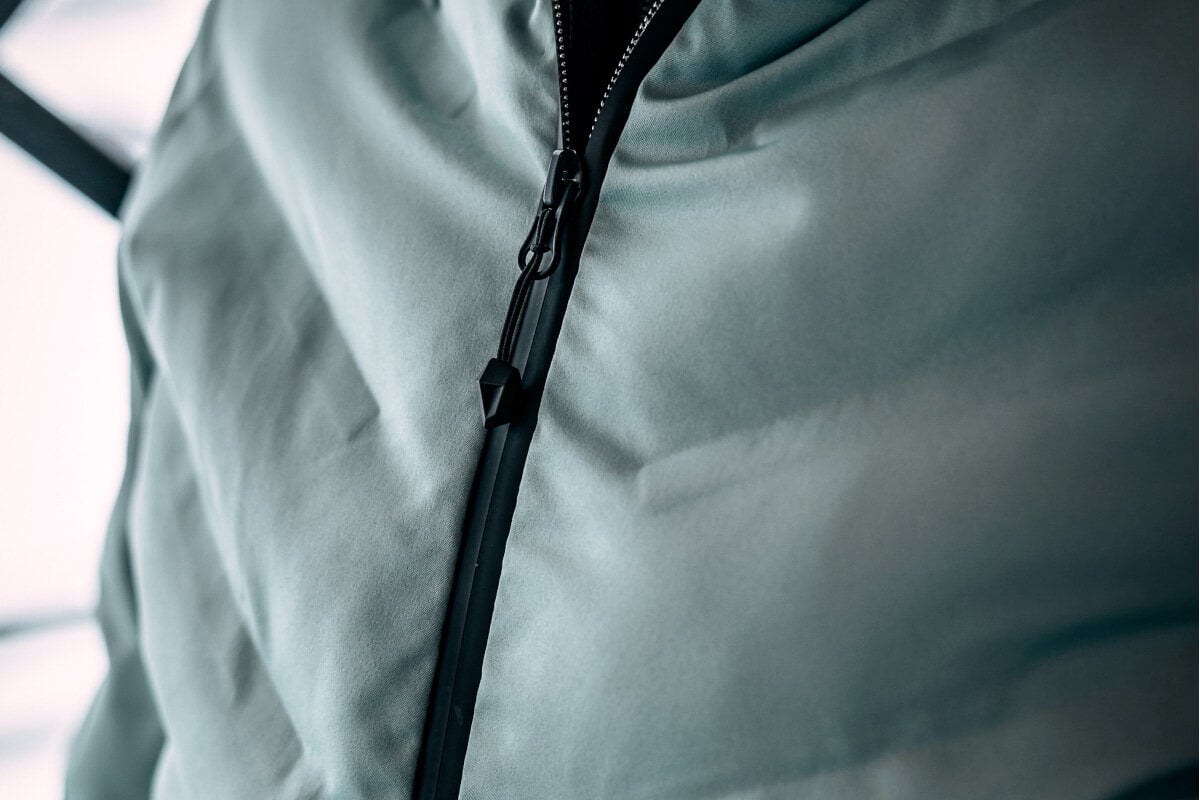When buying a new ski jacket, one of the fundamental factors to consider is the type of insulation you want. Whether synthetic or natural, each material has its own specific characteristics and advantages, offering different functionality to different users.
Key variations between natural and synthetic materials mean that each type of garment is suited to specific uses. This is why it's good to know the differences before choosing your gear.
Weight being equal, natural fibers are warmer than synthetic ones but is also more voluminous. These characteristics make it suitable for extremely cold conditions, which usually occur when the climate is dry. Natural fibers are often hydrophilic, which means they naturally tend to retain moisture and lose some of their insulating capacity when wet. This means they are ideal in the bitter cold, but are not the best choice for intense physical activity. Here are some examples of high-performance natural materials:
Goose feathers have better insulating properties than any other natural plumage. It is an extremely soft and flexible material that offers excellent insulation against the outdoor environment. All weights being equal, the insulation it provides is better than any synthetic material. Goose feathers are extremely compressible, but in normal conditions they have significant volume, so are not the ideal choice for those who prioritize freedom of movement. Feathers do not have water-repellent properties and so they tend to retain moisture and lose their insulating properties when wet. Goose down is the best material to face very low temperatures, but it is not suitable for intense physical activity.
Merino wool is renowned for its extreme softness and breathability, its particular composition also easing thermoregulation of the body. This wool keeps the body warm without raising its temperature too much. Unlike goose feathers, its fibers are hydrophobic at one end and hydrophilic at the other. This characteristic allows it to maintain at least some of its insulating properties even in humid environments. Like most wools, merino contains lanolin, a substance with antibacterial properties. Due to its particularly fine fibers, merino wool is one of the softest wools there is. It offers an excellent insulation-to-weight ratio compared to other wools, thanks to the structure of its fibers, which keep the heat close to the body. Thanks to its ability to maintain part of its insulating properties even when wet, Merino wool is suitable for medium intensity physical activity.
Yet synthetic fibers make for slimline garments of reduced thickness, all to the advantage of freedom of movement. They are particularly useful in humid environments, because synthetic fibers are water-repellent and therefore tend to expel sweat away from the body. This salient feature makes them perfect for intense physical activity and protects the wearer for a significant time even in bad weather. Here are some examples of high-performance synthetic insulating materials, designed for different uses.
To create Cross Core, Primaloft® has combined thin synthetic fibers with Aerogel, an engineered material with unique properties. Originally developed by NASA for use in aeronautical applications, silica aerogel is a low-density, highly porous structure that forms a temperature barrier, preventing the penetration of cold and heat. Aerogel is more than 95% air and it is the lightest solid material known to man. The result is a particularly light and highly insulating fiber, which retains the breathability and water resistance typical of synthetic fibers. An ideal choice for activities that require intense performance and thermal insulation with the lightest possible weight.
Primaloft® Silver is a fusion comprising 80% ultra thin Primaloft® fibers and 20% water-repellent feathers. It is designed to offer excellent insulation and lightness, with soft, thin consistency. The patented Primaloft® treatments guarantee excellent insulating performance even in conditions of high humidity. The excellent insulation-to-thickness ratio means greater warmth in a very thin lining, which is easily folded and can offer great freedom of movement. This makes it an excellent solution for intense physical activity and for those who look for a compact and ergonomic garment.
Compact, light and soft. Like all synthetic fibers, it has excellent water-repellent properties and maintains its insulating properties even when wet. The insulation level of Primaloft® Black is comparable to that of a good natural down jacket. The appearance and feel of its fibers is very similar to those of high-quality goose feathers. Primaloft® Black is the result of a simper process than other Primaloft® solutions and is suited to simple, easy-to-use gear, while always guaranteeing high level performance for physical activity.

Thermore®’s Ecodown padding is a valid alternative to natural down, has a great insulation-to-weight ratio and maintains its characteristics even when there’s moisture. It’s a durable material 100% made from fibers obtained by recycling PET plastic bottles; on average, a garment with Ecodown insulation material makes use of up to 10 recycled bottles, a great solution for limiting waste resulting from our everyday lives.
One characteristic of this insulation material is the special structure directed towards efficiently expelling moisture created by the body. Comfortemp® Quickdry Frame™ incorporates a kind of lattice that can channel excess moisture from perspiration away from the body. That makes it suitable for intense physical activity, when perspiration increases together with the intensity of exercise.
It’s a type of synthetic padding made entirely from recycled food-grade plastic, mostly bottles of various kinds. The plastic transformation process involves reducing it to a very fine material before mixing it, melting it and transforming it into small chips. The result is an insulating material with excellent performance in terms of water-repellency, softness, elasticity and lightness.
Feathers, wool, synthetic fibers and high-tech materials, all different and each with its own salient features and strengths. In order to choose wisely and be sure of purchasing clothes that best suit your needs, you just need to be sure how you plan to use your new gear.